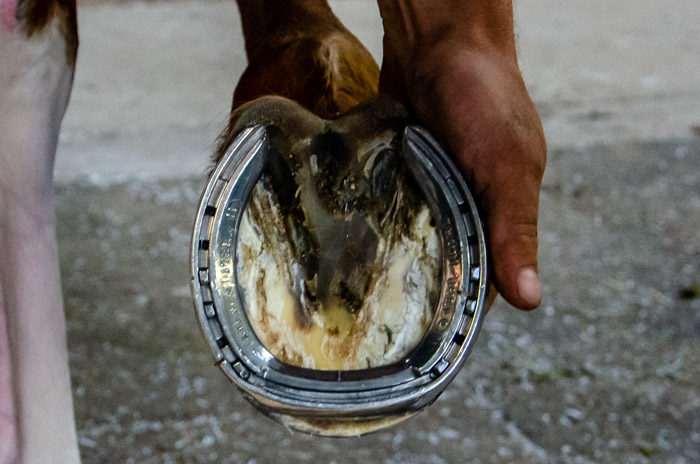The Horseracing Integrity and Safety Authority (HISA) proposes the status quo with its horseshoeing rules, according to its submission to the Federal Trade Commission (FTC).
Section 2276 of HISA’s Racetrack Safety Program, which is dedicated to horseshoes, will allow “full rims 2 millimeters or less in height from the ground surface of the horseshoe” on front hooves while competing or training on dirt surfaces. All other traction devices on the forelimbs are prohibited.
Hindlimb horseshoes may have “full rims 4 millimeters or less in height from the ground surface of the horseshoe, or toe grabs 4 millimeters or less in height from the ground surface of the horseshoe” on dirt surfaces. All other traction devices are prohibited on hindlimb horseshoes.
Horses that race or train on synthetic surfaces may have “full rims that are 2 millimeters or less in height from the ground surface of the horseshoe.” All other traction devices are not allowed on the fronts or hinds.
Traction devices are prohibited in all cases on turf surfaces.
HISA’s Racetrack Safety Program defines a traction device in Section 2010 as “any device that extends beyond the ground surface of the horseshoe and includes but is not limited to inserts, wear plates, rims, toe grabs, bends, jar calks, stickers, ice nails, frost nails, and mud nails.”
The FTC will publish the proposal in the Federal Register for public comment. Changes may be included following public comment before the rule is approved.
Although Section 2276 is edited in the proposal, the shoeing rules changed on July 29, 2022, after a bipartisan quartet of United States senators questioned the “chaotic implementation and poor communication” of the Authority, as well as whether the FTC has the “ability to effectively provide oversight of the Authority and ensure it complies with HISA.” The changes came just days before they were to take effect on Aug. 1.
The original horseshoeing rules, as found on Page 457, state:
“(a) Except for full rims 2 mm or less from the ground surface of the horseshoe, traction devices are prohibited on forelimb and hindlimb horseshoes during racing and training on dirt or synthetic racing tracks.
“(b) Traction devices are prohibited on forelimb and hindlimb horseshoes during training and racing on the turf.
“(c) Traction devices include but are not limited to rims, toe grabs, bends, jar calks and stickers.”
In a statement, HISA’s Racetrack Safety Committee recommended the temporary nonenforcement of Rule 2276 for “horses racing on dirt surfaces that are shod on hindlimbs with traction devices in the form of either a full outer rim shoe (up to 4 mm in height) or a toe grab (up to 4 mm in height).”
The HISA panel was clear that it did not agree with the changes.
“Findings that support the rationale for strongly recommending use of full outer rim shoes rather than toe grabs are the epidemiological data,1 consistency of the association of musculoskeletal injury with toe grabs on the hindlimbs with that of injury of the forelimbs,1-4 findings of the association of a long-toe conformation with racing injury (toe grabs would extend the effective length of the toe),5 expert opinion,6 and evidence from other racing jurisdictions where toe grabs are banned and where injury rates are lower (including Japan, where racing on a dirt surface is prominent),” according to the statement.
References
- Kane AJ, Stover SM, Gardner IA, Case JT, Johnson BJ, Read DH, Ardans AA. Horseshoe characteristics as possible risk factors for fatal musculoskeletal injury of Thoroughbred racehorses. Am J Vet Res 1996;57:1147-1152.
- Hill AE, Stover SM, Gardner IA, Kane AJ, Whitcomb MB, Emerson AG. Risk factors for and outcomes of noncatastrophic suspensory injury in Thoroughbred racehorses. J Am Vet Med Assoc 200;218:1136-1144.
- Hernandez JA, Scollay MC, Hawkins DL, Corda JA, Krueger TM. Evaluation of horseshoe characteristics and high-speed exercise history as possible risk factors for catastrophic musculoskeletal injury in thoroughbred racehorses. Am J Vet Res 2005;66:1314-1320.
- Anthenill LA, Stover SM, Garner IA, Hill AE. Risk factors for proximal sesamoid bone fractures associated with exercise history and horseshoe characteristics in Thoroughbred racehorses. Am J Vet Res 2007;68:760-771.
- Balch OK, Helman RG, Collier MA. Underrun heels and toe-grab length as possible risk factors for catastrophic musculoskeletal injuries in Oklahoma racehorses. Proc AAEP 2001;47:334-337.
- Casner B. 2010 Jockey Club Welfare & Safety Committee Presentation.
- Hitchens PL, Morrice-West AV, Stevenson MA, Whitton RC. Meta-analysis of risk factors for racehorse catastrophic musculoskeletal injury in flat racing. Vet J 2019;25:39-40.









Post a comment
Report Abusive Comment